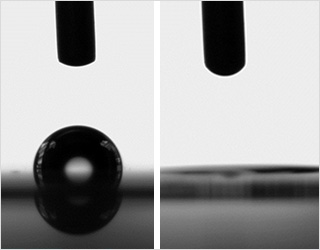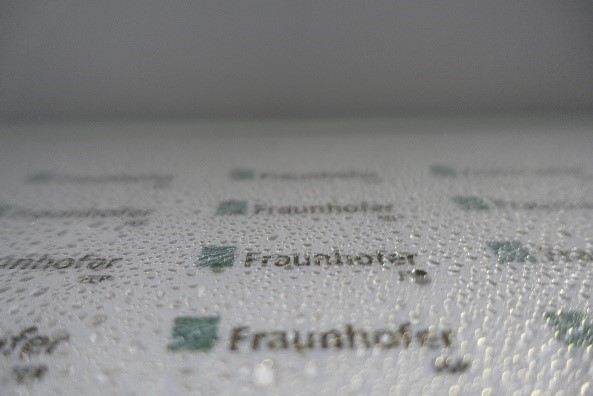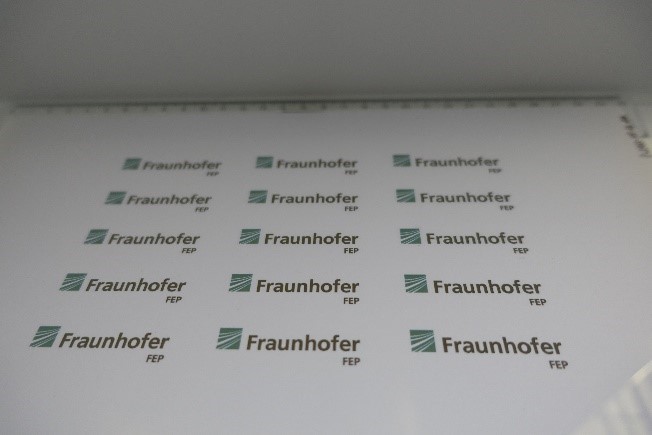02 | 2023 – Hydrophilic coatings from the roll – retrofitting facades and solar panels easily with ultra-thin glass
Cleaning glass facades and solar installations is expensive and time-consuming. Dirt reduces the yield of solar modules. Reasons enough to research surfaces that minimize this effort. The Fraunhofer Institute for Organic Electronics, Electron Beam and Plasma Technology FEP has now succeeded within the European Union-funded NewSkin project (GA: 862100) in applying crystalline titanium oxide to ultra-thin glass using a roll-to-roll process, thus achieving hydrophobic surfaces that become superhydrophilic under UV light. Initial results of this showcase of some of the NewSkin open access upscaling facilities will be presented at the Fraunhofer joint booth, No. C2-528, during BAU 2023, April 17 – 22, in Munich, Germany.



In 2021, photovoltaics covered 8.9 percent of gross electricity consumption in Germany1 with electricity generation of 50 TWh. Of course, this should and must be increased in the interests of a sustainable energy transition. Dirt-repellent, easy to clean surfaces ensure transparency and cleanliness for facades and more efficient and consistent energy production for solar, with less maintenance costs.
"We are focusing on photoinduced hydrophilicity on surfaces here," explains graduate student Valentin Heiser from Fraunhofer FEP. "To upscale this effect, we apply crystalline titanium oxide to ultrathin glass in a roll-to-roll process for the first time. This is very efficient. The ultrathin and lightweight glass can be applied subsequently to facades or directly incorporated into solar modules as a composite material – and even onto curved surfaces."
Titanium dioxide changes its hydrophilicity, i. e. its water repellency, when exposed to UV radiation (i. e. activation by sunlight, for example). Unirradiated, it is hydrophobic, i. e. it forms water drops. After irradiation, it is superhydrophilic, i. e. completely moistening. In the case of photoinduced hydrophilicity, the surface changes from hydrophobic to superhydrophilic after approx. 30 minutes of irradiation with sun-like UV light.
On surfaces with such a titanium dioxide coating, this effect means that no or only very little dirt can be deposited. If, for example, traffic dust, sand or other dirt deposits on glass facades or solar panels, it is washed off by the nightly hydrophobicity of the surface via beading raindrops. In addition, the cyclic alternation of hydrophobic and superhydrophilic properties means that the dirt does not adhere to the surface during the day.
Titanium oxide activated with UV light also decomposes organic molecules on the surface by photocatalysis. This produces antibacterial and sterile surfaces that are of particular interest in medical technology or in connection with flexible displays.
The researchers at Fraunhofer FEP have now developed the first coatings: Specifically, a 30 cm wide and 20 m long roll of thin glass, with a glass thickness of 100 micrometers, was coated with 30 –150 nanometers of titanium oxide, in a roll-to-roll system. This pilot plant for roll-to-roll coating of thin glass (FOSA LabX 330 Glass from VON ARDENNE) is located at Fraunhofer FEP.
One challenge for this showcase project is that thin glass is a very new substrate with significant handling requirements, as it breaks very easily and reacts sensitively to thermal and mechanical stresses. Secondly, titanium dioxide achieves its special properties of hydrophobicity and hydrophilicity only when it is crystalline. For this, it requires high temperatures during production. Sputter coatings with these requirements could not be implemented in roll-to-roll technology until now because common substrates, such as films, could not withstand the high temperatures. This is where thin glass provides an alternative.
Thanks to this work through NewSkin, Fraunhofer FEP scientists are now working on combining the properties of titanium dioxide and thin glass in an optimal and cost-efficient way in order to bring innovative products to market together with industry. The first successful coatings on ultra-thin glass paved the way for this. Researchers from the Newskin partner Uppsala University are working on transferring the results even to polymer films.
In the future, work will also be done by Fraunhofer FEP on layer systems that can be activated not only with UV light but also with visible light. The production and embedding of nanoparticles or doping with nitrogen, for example, are also being considered.
NewSkin Open Innovation Test Bed (OITB) offers unique pilot scale prototyping, upscaling, and testing facilities and route-to-market services available to all, to accelerate the commercialisation of innovative nano-surface and membrane materials and technology across Europe. NewSkin is one of a number of EU-funded OTIBs, and offers research labs, SMEs and industry open access to 10 upscaling and 9 testing state-of-the-art facilities. Resulting enhanced surfaces and membranes accelerated through NewSkin OITB, will provide advanced functionalities, materials protection, water-treatment, tribological applications, fuel savings in transport, efficiencies in renewable energy production and more, impacting society and key industrial sectors and aiding the EU green transition.
Fraunhofer FEP researchers will present initial results of these coatings alongside other highlights at BAU 2023, in Munich, Germany, April 17 – 22, 2023, at the Fraunhofer joint booth No. C2-528.
Fraunhofer FEP at BAU 2023
17 – 23 April 2023
Munich Trade Fair, Germany
Fraunhofer Joint Booth, Hall C2, No 528
About NewSkin OITB
NewSkin – Innovation Eco-System to accelerate the industrial uptake of advanced surface nano-technologies
Funding acknowledgement: NewSkin project has received funding from the European Union’s Horizon 2020 research and innovation programme under grant agreement No. 862100 (NewSkin). The output reflects the views only of the author(s), and the European Commission cannot be held responsible for any use which may be made of the information contained therein.
Project duration: 1 April 2020 – 31 March 2024
NewSkin is an EU Horizon 2020 funded Open Innovation Test Bed (OITB), which aims to support the development and market acceleration of new surface and membrane functionalisation by nanotechnologies, generating a wide range of enhanced surface properties for commercial and personal products in different sectors.
The NewSkin OITB test bed (10 upscaling and 9 testing facilities, and route to market services) offers users open access to state-of-the-art facilities for adding, upscaling, characterising and/or accelerated rigorous testing of advanced high performance surface functionality (such as hydrophobicity, anti-fouling, anti-reflecting, auto-cleaning, anti-corrosive, anti-icing, anti-microbial, anti-friction, hard-wearing, and lubrication) through nanotechnologies. Access is available by contract, as well as free via 4 Open Calls.
Resulting enhanced surface and membrane solutions accelerated through NewSkin OITB, will provide advanced functionalities, materials protection, water-treatment, tribological applications, efficiencies in renewable energy production, fuel savings in transport, energy savings in pumps, engines, actuators, and more, impacting society and key industrial sectors and aiding the EU green transition.
For more information on how to access NewSkin OITB see platform.newskin-oitb.eu.
Relevant Publications of Fraunhofer FEP
2022, Mit Präzision und dünnen Schichten zu tragbarer Elektronik
Fahland, Matthias; Barth, Stephan; Graf, Annett; Vogel, Uwe
IVAM inno magazine, Volume 27, No. 82, September 2022
2022, Low-Energy Electron Beam for Antifouling Coatings
König, Ulla; Gürtler, Nic
IVAM inno magazine, Volume 27, No. 83, November 2022
2022, Polymeric substrate properties tailored by irradiation
Günther, Steffen; Kutschke, Elisa; Bork, Andreas
Vakuum in Forschung und Praxis, Volume 34, Issue 4, page 26-30, 25 August 2022
 Fraunhofer Institute for Organic Electronics, Electron Beam and Plasma Technology FEP
Fraunhofer Institute for Organic Electronics, Electron Beam and Plasma Technology FEP